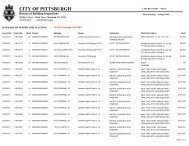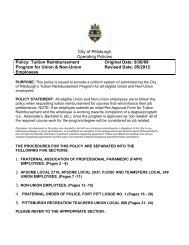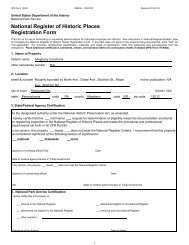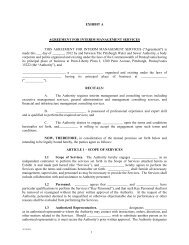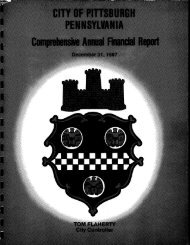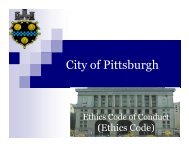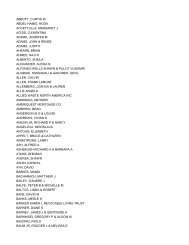east liberty station: realizing the potential - City of Pittsburgh
east liberty station: realizing the potential - City of Pittsburgh
east liberty station: realizing the potential - City of Pittsburgh
Create successful ePaper yourself
Turn your PDF publications into a flip-book with our unique Google optimized e-Paper software.
The market demand had only recently<br />
picked up.<br />
6<br />
store on Penn Avenue which recently<br />
opened in <strong>the</strong> summer <strong>of</strong> 2011.<br />
Redevelopment <strong>of</strong> <strong>the</strong> former Nabisco<br />
bakery on Penn Avenue into <strong>the</strong> mixeduse<br />
Bakery Square continued this<br />
momentum. New higher quality mixedincome<br />
rental and affordable housing<br />
projects commenced alongside <strong>the</strong><br />
commercial revitalization led by <strong>the</strong><br />
efforts <strong>of</strong> ELDI, <strong>the</strong> URS and The<br />
Community Builders. In a little over a<br />
decade, 1,400 public housing units<br />
within three high rise structures –<br />
Liberty Park, East Mall Tower and Penn<br />
Major TOD development opportunities in relation to <strong>the</strong> redesigned <strong>station</strong><br />
Circle Apartments – have been<br />
replaced with 450 new mixed-income<br />
units. While many affordable housing<br />
units were created by 2010, much <strong>of</strong><br />
this new development only included<br />
small amounts <strong>of</strong> market rate/affordable<br />
market rate rentals. Especially limited<br />
are new single family detached units.<br />
Within each core residential area <strong>of</strong><br />
each neighborhood, over 30% <strong>of</strong> <strong>the</strong><br />
housing stock was built before 1940.<br />
The focus on rental housing in East<br />
Liberty has somewhat detracted from<br />
<strong>the</strong> development <strong>of</strong> for-sale units where<br />
In an attempt to continue <strong>the</strong><br />
momentum <strong>of</strong> significant renewal<br />
efforts within <strong>the</strong> study area, <strong>the</strong><br />
latest planning strategy focuses on<br />
TOD as <strong>the</strong> preferred alternative to<br />
reverse decades <strong>of</strong> auto dependent<br />
development. TOD is a method for<br />
organizing relatively compact, high<br />
density mixed-use development<br />
around transit as a means <strong>of</strong><br />
encouraging transit use and creating<br />
more efficient and sustainable land<br />
use patterns. More than simply a<br />
project next to a train <strong>station</strong>, it<br />
represents <strong>the</strong> creation <strong>of</strong> a<br />
walkable, active and beautiful place<br />
centered-around transit access at a<br />
human scale. The approach aims to<br />
create healthy, connected<br />
neighborhoods with integration<br />
between <strong>the</strong> <strong>station</strong> and <strong>the</strong><br />
surrounding community.<br />
TOD provided a synergy between<br />
economic, land use, transportation,<br />
environmental, housing and social<br />
equity goals. By facilitating public<br />
transit use, this development type<br />
can reduce dependence on fossil<br />
fuels, lower residents’ transportation<br />
costs, ease congestion, improve<br />
safety, promote walking/health and



